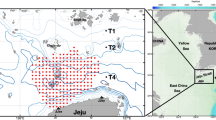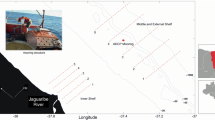Abstract
To examine the surface circulation and vertical structure of currents in the region of the Keum River (KR) plume, we analyzed the subinertial surface currents obtained by high frequency radar and the vertical profiles of currents measured at a station (M1) located 10 km distance from the estuary mouth for one month in late spring 2008. Monthly-mean surface circulation is composed of the westward flow from the estuary mouth and the northward flow in the offshore. These surface mean currents are a gradient (geostrophic) current around the monthly-mean plume bulge. Dominant variabilities of the surface currents, winds, and KR-outflow are decomposed by the Empirical Orthogonal Functions (EOF). The first current EOF mode, explaining 39% of total variation, is primarily related to the first wind EOF mode varying along the coast and the second current mode, explaining 33% of total variation, is mainly related to the first KR-outflow EOF mode varying along the mean KR-outflow direction. Meanwhile, vertical profile of the monthly-mean current at M1 shows a two-layer structure of the current flowing offshore (onshore) in the upper (lower) layer because the water column is divided by a pycnocline at 7-9 m depths below the plume water. This two layer structure is a background persisting current structure, at least in spring, maintained by the geostrophic balance induced by the sea level slope and density gradient along the line normal to the westward mean surface current direction due to monthly-mean plume bulge off the KR estuary. EOF analysis of vertical current profiles reveals that the first mode, explaining 43% of total variation, represents the two-layer structure of the current variability. The upper-layer current varies along a line normal to the mainland coastline and the low-layer one varies approximately along a line parallel to the coastline, with direction difference of about 115° between the upper-and low-layer. From the correlation analysis it is found that 60% of the first mode variation is influenced by the first mode of KR-outflow and 36% by the first mode of wind. Any forcing modes of KR-outflow and wind influencing the other current vertical modes could not be found in the present study.
Similar content being viewed by others
References
Avicola G, Huq P (2003) The role of outflow geometry in the formation of the recirculating bulge region in coastal buoyant outflows. J Mar Res 61(4):411–434
Barrick DE, Evans MW, Weber BL (1977) Ocean surface currents mapped by radar. Science 198:138–144
Baek HY (2008) Characteristics of sea level, tidal and subinertial current variations in the Saemangeum coastal area. M.D. Thesis, Kunsan National University, 85 p (in Korean)
Bowden KF (1983) Physical oceanography of coastal waters. Ellis-Horwood, New York, 302 p
Chant RJ, Glenn SM, Hunter E, Kohut J, Chen RF, Houghton RW, Bosch J, Schofield O (2008) Bulge formation of a buoyant river outflow. J Geophys Res 113:C01017. doi:10.1029/2007JC004100
Chao SY (1990) Tidal modulation of estuarine plumes. J Phys Oceanogr 20(7):1115–1123
Chapman RD, Shay LK, Graber HC, Edson JB, Karachintsev A, Trump CL, Ross DB (1997) On the accuracy of ocean radar surface current measurements: inter-comparisons with shipbased sensors. J Geophys Res 102(C8):18737–18748
Choi B-J, Wilkin JL (2007) The effect of wind on the dispersal of the Hudson River plume. J Phys Oceanogr 37:1878–1897. doi:10.1175/JPO3081.1
Choi HY, Lee SH, Yoo KY (1999) Salinity distribution in the mideastern Yellow Sea during the high discharge from the Keum River weir. J Korean Soc Oceanogr 4:1–9 (in Korean)
de Boer GJ, Pietrzak JD, Winterwerp JC (2008) Using the potential energy anomaly equation to investigate tidal straining and advection of stratification in a region of freshwater influence. Ocean Model 22:1–11
Emery WJ, Thomson RE (2004) Data analysis methods in physical oceanography. Elsevier, Amsterdam, 638 p
Ekman WW (1905) On the influence of the earth’s rotation on ocean currents. Ark Mar Astr Fys 2:1–53
Fernandez DM, Vesecky JF, Teague CC (1996) Measurements of upper ocean surface current shear with high frequency radar. J Geophys Res 101(C12):28615–28625
Fong DA, Geyer WR, Signell RP (1997) The wind-forced response on a buoyant coastal current: observations of the western Gulf of Maine plume. J Marine Syst 12:69–81
Fong D, Geyer RW (2002) The alongshore transport of freshwater in a surface-trapped river plume. J Phys Oceanogr 32:957–972
Garvine RW (1995) A dynamical system for classifying buoyant coastal discharges. Cont Shelf Res 15(13):1585–1596
Halverson MJ, Pawlowicz R (2008) Estuarine forcing of a river plume by river flow and tides. J Geophys Res 113:C09033. doi:10.1029/2008JC004844
Heaps NS (1972) Estimation of density currents in the Liverpool Bay area of the Irish Sea. Geophys J Roy Astr S 30 415–432
Hickey BM, Pietrafesa LJ, Jay DA, Boicourt WC (1998) The Columbia River plume study: subtidal variability in the velocity and salinity fields. J Geophys Res 103(C5):10339–10368.
Hickey B, Geier S, Kachel N, MacFadyen A (2005) A bi-directional river plume: the Columbia in summer. Cont Shelf Res 25: 1631–1656
Horner-Devine AR, Fong DA, Monismith SG, Maxworthy T (2006) Laboratory experiments simulating a coastal river outflow. J Fluid Mech 555:203–232
Horner-Devine AR, Jay DA, Orton PM, Spahn EY (2009) A conceptual model of the strongly tidal Columbia River plume. J Marine Syst 78:460–475
Imasato N (1983) What is tide-induced residual current? J Phys Oceanogr 13:1307–1317
Jay DA, Pan J, Orton PM, Horner-Devine AR (2009) Asymmetry of Columbia River tidal plume fronts. J Marine Syst 78:442–549. doi:10.1016/j.jmarsys.2008.11.015
Jurisa JT, Nash JD, Moum JN, Kilcher LF (2016) Controls on turbulent mixing in a strongly stratified and sheared tidal river plume. J Phys Oceanogr 46(8):2373–2388.
Kim CS, Lee SH, Son YT, Kwon HK, Lee KW, Choi BJ (2008a) Variations in subinertial surface currents observed with HF radar in the coastal waters off the Saemangeum area. J Korean Soc Oceanogr 13(1):56–66 (in Korean)
Kim SR, Terill EJ, Cornuelle BD (2008b) Mapping surface currents from HF radar radial velocity measurements using optimal interpolation. J Geophys Res 113:C10023. doi:10.1029/ 2007JC004244
Kim SR, Cornuelle BD, Terill EJ (2009) Anisotropic response of surface currents to the wind in a coastal region. J Phys Oceanogr 39(6):1512–1533
Kundu PK (1976) Ekman veering observed near the ocean bottom. J Phys Oceanogr 6:238–242
Lee SH, Choi HY, Oh IS (1995) Structure and variability of the Keum River plume in summer. J Korean Soc Oceanogr 30:125–137 (in Korean)
Lee SH, Kwon HK (1999) Physical environment changes in the Keum River estuary by the dyke gate operation. II. Salinity structure and estuary type. J Korean Soc Oceanogr 4:93–100 (in Korean)
Lee SH, Choi HY, Kwon HK (2001) Physical environment changes in the Keum River Estuary due to dike gate pperation: III. Tidal modulation of low-salinity water. J Korean Soc Oceangr 6(3):115–125 (in Korean)
Lee S-H, Choi HY, Son YT, Kwon HK, Kim YK, Yang JS (2003) Low-salinity water and circulation in summer around the Saemangeum area in the west coast of Korea. J Korean Soc Oceanogr 8(2):138–150 (in Korean)
Lee S-H, Moon HB, Baek HY, Kim CS, Son YT, Kwon HK, Choi B-J (2008) On the accuracy of current measurement by HF radar in the coastal sea off the Keum River estuary. J Korean Soc Oceanogr 13(1):42–55 (in Korean)
Lee S-H, Kang CY, Choi B-J, Kim CK (2013) Surface current response to wind and plumes in a bay-shape estuary of the eastern Yellow Sea: ocean radar observation. Ocean Sci J 48(1):117–139
McCabe RM, MacCready P, Hickey BM (2009) Ebb-tide dynamics and spreading of a large river plume. J Phys Oceanogr 39:2839–2856. doi:10.1175/2009JPO4061.1
Nash JD, Kilcher LF, Moum JN (2009) Structure and composition of a strongly stratified, tidally pulsed river plume. J Geophys Res 114:C00B12. doi:10.1029/2008JC005036
Pritchard M, Huntley DA (2006) A simplified energy and mixing budget for a small river plume discharge. J Geophys Res-Oceans 111:C03019. doi:10.1029/2005JC002984
Rikiishi K, Ichiye T (1986) Tidal fluctuation of the surface currents of the Kuroshio in the East China Sea. Prog Oceanogr 17: 193–214
Shin EJ, Lee S-H, Choi HY (2002) Numerical model study for structure and distribution of the Keum River Plume. J Korean Soc Oceanogr 7:157–170 (in Korean)
Simpson JH (1997) Physical processes in the ROFI regime. J Marine Syst 12:3–16
Simpson JH, Bowers D (1981) Models of stratification and frontal movements in shelf seas. Deep-Sea Res 28:727–738
Simpson JH, Brown J, Matthews J, Allen G (1990) Tidal straining, density currents, and stirring in the control of estuarine stratification. Estuaries 13(2):125–132
Son YT, Lee S-H, Kim CS, Lee JC, Lee GH (2007) Surface current variability in the Keum River Estuary (South Korea) during summer 2002 as observed by high-frequency radar and coastal monitoring buoy. Cont Shelf Res 27:43–63
Taylor JR, Sarkar S (2008) Stratification effects in a bottom Ekman layer. J Phys Oceanogr 38:2535–2555. doi:10.1175/2008JPO3942.1
Thompson RORY (1983) Low-pass filters to suppress inertial and tidal frequencies. J Phys Oceanogr 13(6):1077–1083
Verspecht F, Rippeth TP, Howarth MJ, Souza AJ, Simpson JH, Burchard H (2009) Processes impacting on stratification in a region of freshwater influence: application to Liverpool Bay. J Geophys Res 114:C11022. doi:10.1029/2009JC005475
Yankovsky AE, Hickey BM, Munchow AK (2001) Impact of variable inflow on the dynamics of a coastal buoyant plume. J Geophys Res 106(C9):19809–19824
Author information
Authors and Affiliations
Corresponding author
Rights and permissions
About this article
Cite this article
Lee, SH., Kim, MJ., Kim, CS. et al. Surface circulation and vertical structure of current off the Keum River estuary, Korea in later spring 2008. Ocean Sci. J. 52, 307–327 (2017). https://doi.org/10.1007/s12601-017-0043-2
Received:
Revised:
Accepted:
Published:
Issue Date:
DOI: https://doi.org/10.1007/s12601-017-0043-2




